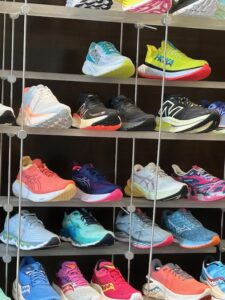 No doubt about it. “Shoes” are big business. it is estimated that footwear will represent nearly four hundred billion dollars in global sales in 2023.
No doubt about it. “Shoes” are big business. it is estimated that footwear will represent nearly four hundred billion dollars in global sales in 2023.
Of course, different people buy shoes for different reasons.
Some women stuck in the time warp of “Sex in the City” syndication pine over Manolo Blahnik shoes because the main character, Carrie Bradshaw, wore them. In the ‘80s and ’90s, who didn’t want to “be like Mike” and wear Nike?
Brands can confer status based on the endorsement of celebrities or might represent qualities that people want – longevity, style, value.
Shoes can represent a small item that gives the purchaser the feeling of luxury or can stand as a reminder of lack.
Shoes are a complicated topic for me. I have friends that have over fifty pairs of shoes (almost unfathomable to me — at one time!).
I can see how shoes can “complete” an outfit, but owning a certain brand has never been a must. I buy a few pairs of sandals most summers and nice boots every five years or so.
My shoe buying philosophy runs along the lines of combining Guinness and Harp beers for a dependable drink. Black and tan shoes “go with everything.”
I think of my personal style as being expressed in my sense of humor or choice of music and books, not based on what I wear. I recognize the importance of first impressions, but largely, I don’t think of myself in terms of how I look.
And then, there’s the money thing. Even though some people derive great pleasure from having an abundance of footwear choices, I can’t help but think in terms of what else could be bought for the retail value of the collection.
Besides, my feet are hard to fit. Shoes are usually uncomfortable. I prefer to go barefoot whenever possible.
For me, shoe-shopping seems to be another reminder than I don’t fit in easily, that I can’t wear standard sizes, etc.
Before I left for my trip to Spain this past October, I knew I had to get walking shoes, some with good support but nothing too heavy as I expected to pack them.
I bought a pair, a good European brand from a clearance rack and, within a week, discovered that they were not comfortable for anything beyond a stroll around the store. Then I did something I thought I would never do. I went to a specialty running store, one that featured New Balance.
I am not an athlete or a runner. I couldn’t imagine spending close to two hundred dollars on a pair of walking shoes. But shopping at this specialty shoe store was a new experience for me.
I wasn’t just asked what size I wore, I was led to some sort of floor mounted x-ray machine. The salesman observed me walk around the room. He looked at the pattern of wear on the soles of the shoes I wore into the store.
I tried on a few pair.
The salesman suggested I consider extra width and explained different designs for maximum arch support.
He introduced a “stabilization” model, which he said, ultimately could improve my gait and limit uneven wear on my soles. He ended his pitch by advising me to choose what FELT most comfortable.
I bought a pair shoes with their “stability” feature. I took them on vacation with me. I believe having comfortable shoes kept my mind on the curiosity of the moment and not on my aching feet.
The premium I paid for shoes that really fit — and the experience I had being “fitted” to my unique needs — was well worth it.
It sometimes takes practice, trying on a new belief, like trying on a premium-priced article of clothing.
Being comfortable in your shoes and getting the personal attention of a sales consultant is no small thing.


Leave a comment